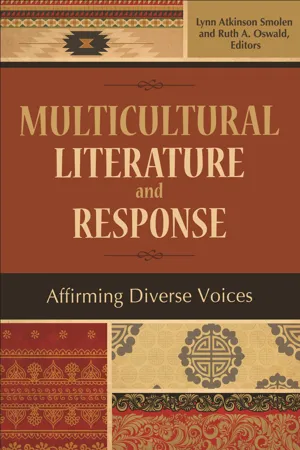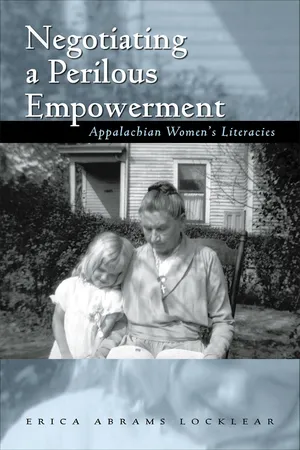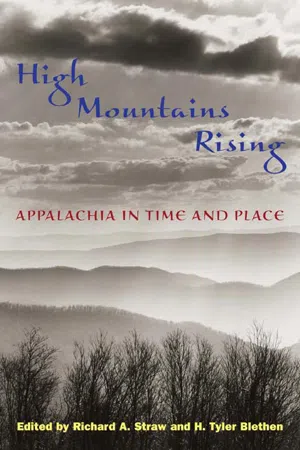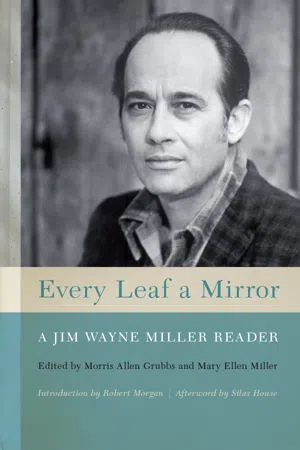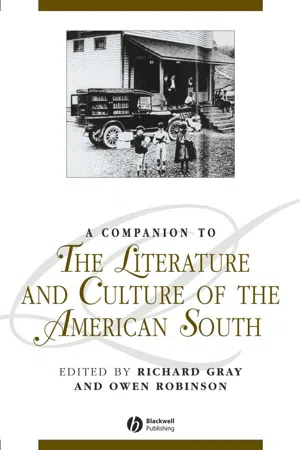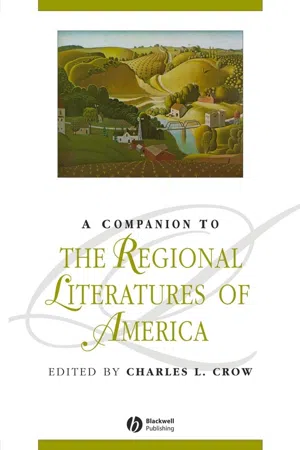Literature
Appalachian Fiction
Appalachian fiction refers to literature that is set in the Appalachian region of the United States and often explores the lives, culture, and struggles of the people who live there. These stories typically feature themes of poverty, family, and the impact of industrialization on rural communities. Authors such as Ron Rash and Lee Smith are known for their contributions to this genre.
Written by Perlego with AI-assistance
Related key terms
1 of 5
6 Key excerpts on "Appalachian Fiction"
- eBook - PDF
Multicultural Literature and Response
Affirming Diverse Voices
- Lynn Atkinson Smolen, Ruth A. Oswald Ph.D., Lynn Atkinson Smolen, Ruth A. Oswald Ph.D.(Authors)
- 2010(Publication Date)
- Libraries Unlimited(Publisher)
The more common geographic interpretation and understanding of Appalachia is focused on the central and southern mountain ranges, including Alleghany of Virginia and West Virginia, Blue Ridge of the Carolinas and Great Smoky Mountains of Tennessee. The children’s literature associated with Appalachia is primarily set in these three mountainous areas (Schmidt, 1992, p. 70). Schmidt’s definition of the literature is similar to that used by the AppLit Web site at http://www.ferrum.edu/applit/about, accessed on October 03, 2010, which states, “in the interest of providing a point of reference, when AppLit pages use the term Appalachia, we are referring to the mountainous regions of Kentucky, Virginia, Tennessee, South Carolina, North Carolina, Georgia, and Alabama; all of the mountain state of West Virginia; and the hilly region of southern Ohio. Additionally, when we use the term Appalachian literature, we are referring to literature written about this particular region and its people.” Defining the exact area that constitutes Appalachian children’s literature is sometimes difficult to pinpoint. There are differences in thought even among the scholars and other experts who study the region. So, for the purpose of this chapter, the definition will serve as a broader one, one that includes the mountain region literature as defined above. In reference to the important scholarship related to the area that began to arise in the 1960s and that has continued until the present, there have been a number of Appalachian studies, programs, and centers established in academic institutions within Appalachia that have various missions. - eBook - PDF
Negotiating a Perilous Empowerment
Appalachian Women's Literacies
- Erica Abrams Locklear(Author)
- 2011(Publication Date)
- Ohio University Press(Publisher)
As the twentieth century progressed, Appalachian writers slowly started publishing their own work, as when in 1940 James Still published River of Earth , a text many scholars consider one of the most important works of Appalachian Fiction. Roughly twenty years later, native Appalachian Cratis Williams wrote the first disser-tation about Appalachian literature, and since then new mountain writing and criticism have continued to flourish. These writers have often focused 26 chapter 1 on literacy in their writing, but women writers in particular have repeatedly depicted the consequences of literacy attainment in their stories and mem-oirs, signaling a persistent anxiety over literacy tropes. The authors consid-ered in this study continually return to scenes in which characters gain new literacies that produce significant internal and external conflict. The tradition of Otherness from which these authors work also provides an important backdrop for my purposes in revealing the identity conflicts that literacy attainment often causes for Appalachians. The notion of Ap-palachia began well over a century ago, and a number of scholars, including Henry Shaprio (1978), Allen Batteau (1990), and John Alexander Williams (2002), have posited varying theories about the events that led to the con-ception of Appalachia as markedly different from the rest of the American South. Perhaps the most ubiquitous and most often challenged idea argues that as industrialization crept its way southward during the Reconstruction years, the majority of mountainous regions in the South remained agricul-tural, if only because the steep hillsides and deep valleys of Appalachia did not readily lend themselves to the kind of frequent travel that characterizes industry and commerce. - eBook - ePub
High Mountains Rising
Appalachia in Time and Place
- Richard A. Straw, H. Tyler Blethen, Richard A. Straw, H. Tyler Blethen(Authors)
- 2010(Publication Date)
- University of Illinois Press(Publisher)
Surprisingly, Miller’s 1977 article is the most recent comprehensive survey of Appalachian literature. Certainly, Miller’s article and the other previously published overviews exploring the region’s literary history are outdated today. Continuing the effort begun by previous scholars, this chapter endeavors to trace the evolution of Appalachian literature from the earliest English-language writings about the region through relevant literary works published at the end of the twentieth century. When addressing literary works written since 1977, I will attempt to elucidate the new themes— as well as the reinterpretations of older themes—that reflect more recent socioeconomic changes within and outside the region. Duly noted will be significant developments in the critical and popular receptions of Appalachian literature, whether works by individual authors or the region’s literary canon as a whole.The earliest and most ambitious of the previously published efforts to survey Appalachian literature was Cratis Williams’s 1961 dissertation “The Southern Mountaineer in Fact and Fiction,” which has long been one of the most influential texts in the interdisciplinary field of Appalachian studies. Williams’s dissertation was not a truly comprehensive study of the region’s literature; he assessed representations of Appalachian people and culture exclusively in novels and narrative nonfiction works published through the 1950s and ignored nonnarrative literary genres (e.g., certain types of nonfiction, poetry, lyric songs).W. D. Weatherford’s and Wilma Dykeman’s impressionistic 1962 essay in The Southern Appalachian Region: A Survey (edited by Thomas R. Ford) investigated a wider range of literary genres than did Williams’s dissertation, yet the former is more problematic from a scholarly standpoint. While accounting for a wide range of literary works about the region or by regional authors through the 1950s, Weatherford’s and Dykeman’s essay expressed positions that are today considered romantic or fallacious. For example, claiming that “the traditional folk arts may well find their last refuge between the covers of a few books,” Weatherford and Dykeman inadvertently endorsed the practice of literary “fakelore” found in many twentieth-century books about Appalachia. When discussing Richard Chase’s The Jack Tales (1943) and Grandfather Tales (1948), Weatherford and Dykeman declared that Chase’s collections of texts from those two Appalachian story cycles “record as faithfully as possible the way these stories sound when they are spoken by the human voice rather than the way they look when they are read on the printed page,” overlooking the fact that Chase’s published versions of those stories from the oral tradition were self-consciously folksy montages of oral texts collected originally from multiple storytellers.3 - eBook - ePub
Every Leaf a Mirror
A Jim Wayne Miller Reader
- Morris Allen Grubbs, Mary Ellen Miller, Morris Allen Grubbs, Mary Ellen Miller(Authors)
- 2014(Publication Date)
- The University Press of Kentucky(Publisher)
Perhaps there is still time for literary critics and historians to help readers learn to prefer rooted diversity to rootless uniformity. Perhaps the time will come when we will have torn down the fence between the regional and the universal, and the old error will no longer need correcting; when book reviewers will routinely distinguish between books of a region and books merely about a region. When that time comes, it will be easier for readers and reviewers alike to see the regional as potentially universal.Passage contains an image
Appalachian LiteratureA Region AwakensThis essay and the poem that follows, “Appalachian Kentucky and the Cycle of American Literature,” appeared together in 1993 in Across the Ridge: The Newsletter of the Appalachian Civic Leadership Project. A version also appeared the same year as the afterword to A Gathering at the Forks: Fifteen Years of the Hindman Settlement School Appalachian Writers Workshop, edited by George Ella Lyon, Jim Wayne Miller, and Gurney Norman.Back in the 1940s and 1950s, Lawrence County, Kentucky, native Cratis Williams attempted to find a university where he could write a doctoral dissertation about the literature of the Appalachian South. He couldn’t find a graduate English department in his home state, or in North Carolina, where he was living, or in any other southern state that would permit him to undertake the serious study of Appalachian literature.In those days the very term “Appalachian literature” struck most graduate English professors as a contradiction in terms. Why, there was no such thing! At the very most, a few folk tales and ballads. The most tolerant response that Williams received was: “If you want to study Appalachian literature, take a couple of weeks off and read it!” Either there was no such thing as Appalachian literature, or, if there was, there wasn’t much of it; and however much there was, it wasn’t of a quality to merit serious study.The attitude that Cratis Williams encountered was nothing new in the American experience. The English once denied that there was such a thing as American literature—at least, any worth reading. In 1820 an English critic asked derisively, “Who reads an American book?” At that moment most of the people were living who would produce what we now know as the - Richard Gray, Owen Robinson, Richard Gray, Owen Robinson(Authors)
- 2008(Publication Date)
- Wiley-Blackwell(Publisher)
It’s easy to see now that this one novel is probably the seminal work for current Appalachian Fiction. It’s where we all come from now, whether we know it or not. She’s the mother of us all’’ (Chappell 1996: 56). Southern Appalachia 145 Ultimately, for all true Appalachian writers, the task has been to claim the literature for themselves, to make the magic of the written word give voice to the power of the voice on the wind, the song in the holler. Jim Wayne Miller, such a powerful figure in this lively community full of powerful folks, said: ‘‘Writing that allows us to ‘live with’ people rather than ‘look at’ them is preferable’’ (Miller 1977: 87) and again, ‘‘the most vigorous literature of the Appalachian region [is] the writing which is an expression of the region and not a report on it’’ (Miller 2001). Poet, novelist, essayist, and environmentalist Wendell Berry says simply, in a famous phrase, Appalachian literature is ‘‘local life aware of itself.’’ And Wilma Dykeman succinctly sums things up when she says Appalachian literature is ‘‘as unique as churning butter and as universal as getting born’’ (quoted in Miller 1977: 90). Eschewing Mary Noailles Murfree as the creator who gave them to themselves, who ‘‘discovered’’ them into existence, the powerful mountain writers of the last eighty years have found that the story of who they were was inside them all along. ‘‘Finding out about yourself,’’ says Jim Wayne Miller, can be a political act in itself . . . . Believing a new thing about yourself may involve assimilating something that is very old, something out of the past. And the new thing will not make you someone else, but will make you realize who you have been all along. (Quoted in Williamson 1979: 274) N OTES 1 For a different perspective on Murfree’s work as a local color/regionalist writer, see Marjorie Pryse, ‘‘Exploring Contact: Regionalism and the ‘Outsider’ Standpoint in Mary Noailles Murfree’s Appa-lachia,’’ Legacy 17, 2 (2000): 199–212.- Charles L. Crow(Author)
- 2008(Publication Date)
- Wiley-Blackwell(Publisher)
The Dial , for example, writes: [Murfree’s stories] deal with the rudest and humblest class of people – the inhabitants of the rough mountain regions of Tennessee who, never descending to the valleys or meeting with a higher grade of civilization, live on from generation to generation, destitute of learning, of religion, of every refining influence of civilization. ( Dial 1884: 43) There is a strong sense here of an assumed cohesiveness among narrative voice, reviewer, and reading public – those who share “the refining influence of civilization.” By focus-ing on the differences of the mountain culture (differences that already have been shaped through the “observing” narrative voice of Murfree’s fiction, and that already have been filtered through Murfree’s own leisure-class assumptions), this review participates in the creation of that imagined, “civilized,” cohesive community. 2 The desire to write Appalachia into a region that could be possessed by the larger culture happened just at the close of Reconstruction, just as the federal presence was leaving the South. Through these literary texts, this white, Southern region was contained and made safe just at the moment when the larger culture wanted to distance itself from the challenges to regional and racial identity that Reconstruction had made possible. Represented as a region set apart from the nation, Appalachia was understood to be part neither of the Union nor of the Confederacy; and thus perhaps part of the cultural fascination with the region stemmed from its ability to elide Reconstruction’s challenges to regional identity. And yet, at the same time, the Region and Race 65 newly discovered region was identified with the South – not only through its geo-graphic borders, but also because the mountain people were represented through the already recognizable stereotype of the poor white Southerner.
Index pages curate the most relevant extracts from our library of academic textbooks. They’ve been created using an in-house natural language model (NLM), each adding context and meaning to key research topics.
